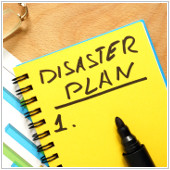 When disaster strikes, organizations need to put their business continuity plans into action and recover their IT systems as quickly as possible. Failing to do so can mean serious financial and reputational repercussions. Despite this, investments in disaster recovery are set aside each year for high-tech IT investments, and every year companies and employees continue to suffer for it. Here are some reasons why disaster recovery is well worth your time, effort, and resources in 2017.
When disaster strikes, organizations need to put their business continuity plans into action and recover their IT systems as quickly as possible. Failing to do so can mean serious financial and reputational repercussions. Despite this, investments in disaster recovery are set aside each year for high-tech IT investments, and every year companies and employees continue to suffer for it. Here are some reasons why disaster recovery is well worth your time, effort, and resources in 2017.
DR isn’t a huge investment
A common misconception about disaster recovery is that it’s a large, bank-breaking investment. Expensive secondary data centers, networks, and server maintenance usually come into mind when a business owner is confronted with the idea of business continuity. And while that may have been true in the past, establishing a strong disaster recovery plan today is as simple — and as cheap — as going to a cloud-based disaster recovery provider and paying for the data and services that your business needs. Subscription pricing models are actually incredibly low, meaning you can have minimal downtime while still having enough to invest in new tech.
Onsite backups just won’t cut it
Although you might feel secure with a manual backup server down the hall, it is still susceptible to local disasters and, ultimately, does very little in minimizing company downtime. When disaster recovery solutions are hosted in the cloud or in a virtualized server, restoring critical data and applications only take a few minutes.
Business disasters can be man-made, too
Even if your workplace is nowhere near frequent disaster zones, cyber attacks and negligent employees can leave the same impact on your business as any natural disaster can. Setting a weak password, clicking on a suspicious link, or connecting to unsecured channels is enough to shut down a 5-, 10-, or even 50-year-old business in mere minutes.
Sure, installing adequate network security is a critical strategy against malicious actors, but last year’s barrage of data breaches suggests that having a Plan B is a must. A suitable disaster recovery plan ensures that your data’s integrity is intact and your business can keep going, no matter the malware, worm, or denial-of-service attack.
Downtime will cost you
A business without a DR plan might come out unscathed after a brief power outage, but why risk the potential damages? Either way, downtime will cost your business. First, there’s the general loss of productivity. Every time your employees aren’t connected to the network, money goes down the drain. Then there’s the cost of corrupted company data, damaged hardware, and the inevitable customer backlash. Add all those variables together, and you end up with a business-crippling fee.
So, if you want 2017 to be the best year for your business, make the smart choice and proactively take part in creating your company’s business continuity plan. Your business will be in a better position financially with it than without it.
Keep your business safe, recover from any disaster, and contact us today.



 Earlier this year, thousands of Delta passengers worldwide were grounded due to a power outage that halted critical IT operations. This was a huge problem not only for the many delayed travelers, but also for the airline company itself. Within three days, the airline company cancelled around 2300 flights and paid over millions of dollars in downtime costs. But if you weren’t personally affected, why should you care? Well, without a business continuity in place, companies like yours can face the same repercussions. In order to prevent that, take heed of some poignant lessons companies can learn from Delta’s IT failings.
Earlier this year, thousands of Delta passengers worldwide were grounded due to a power outage that halted critical IT operations. This was a huge problem not only for the many delayed travelers, but also for the airline company itself. Within three days, the airline company cancelled around 2300 flights and paid over millions of dollars in downtime costs. But if you weren’t personally affected, why should you care? Well, without a business continuity in place, companies like yours can face the same repercussions. In order to prevent that, take heed of some poignant lessons companies can learn from Delta’s IT failings.




 Do you know when to invoke your Business Continuity Plan? A lot of business owners assume they know when it will be required, but the reality is that it can be hard to determine when a BCP is really necessary. It’s important you are able to assess what is taking place, and make an informed decision with regard to putting your continuity strategy into action. Here are few things you need to consider when it comes to invoking your plan.
Do you know when to invoke your Business Continuity Plan? A lot of business owners assume they know when it will be required, but the reality is that it can be hard to determine when a BCP is really necessary. It’s important you are able to assess what is taking place, and make an informed decision with regard to putting your continuity strategy into action. Here are few things you need to consider when it comes to invoking your plan.